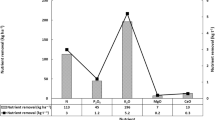Abstract
Nitrogen and water deficiencies are known to affect potato yield, but much less is known of their effect on tuber growth and biomass partitioning. The objective of this on-farm study conducted at two sites in each of three years, 1995 to 1997, was to determine the effects of supplemental irrigation and N fertilization rates on tuber growth and biomass partitioning of the cultivars Shepody and Russet Burbank. The N fertilization rates were 0,100, and 250 kg N ha-1in 1995, and 0, 50,100, and 250 kg N ha−1 in 1996 and 1997. The highest bulking rate observed in our study (7.3 g fresh tubers m-2 °C-1) can be considered near the potential bulking rate in New Brunswick. The water deficit in the absence of supplemental irrigation reduced this potential bulking rate by as much as 40%, but this reduction was much less at five of six sites and negligible at two of six sites. Nitrogen deficiency reduced the bulking rate at two of six sites. This negative effect of N deficiency on bulking rate was greater with irrigation than without irrigation at two of six sites; the tuber bulking rate with irrigation was reduced by as much as 50% with no N applied at one site. Shepody had a greater bulking rate than Russet Burbank. The tuber bulking of Russet Burbank, however, started earlier and lasted longer than that of Shepody. Water and N deficiencies increased biomass partitioning to tubers and large roots. Shepody partitioned a greater proportion of its biomass to large roots and had a greater root biomass than Russet Burbank. Our results demonstrate the ability of potatoes to modify biomass partitioning when grown under water and/or N stresses. As a result of this compensation, the reduction in tuber yield due to limited N and water stresses is minimized.
Similar content being viewed by others
Literature Cited
Bélanger, G., J.R. Walsh, J.E. Richards, P.H. Milburn, and N. Ziadi. 2000. Yield response of two potato cultivais to supplemental irrigation and N fertilization in New Brunswick. Am J Potato Res 77:11–21.
Biemond, H. and J. Vos. 1992. Effects of nitrogen on the development and growth of the potato plant. 2. The partitioning of dry matter, nitrogen and nitrate. Ann Bot 70:37–45.
Curwen, D. and L.R. Massie. 1984. Potato irrigation scheduling in Wisconsin. Am Potato J 61:235–241.
Duchenne, T., J.M. Machet, and M. Martin. 1997. Potatoes. In: Lemaire, G. (ed), Diagnosis of the Nitrogen Status in Crops. Springer, Berlin. pp. 119–130.
Dyson, P.W. and D.J. Watson. 1971. An analysis of the effects of nutrient supply on the growth of potato crops. Ann Appl Biol 69:47–63.
Genstat 5 Committee. 1993. Genstat 5 Release 3 Reference Manual. Clarendon Press, Oxford, UK
Harris, P.M. 1992. Mineral nutrition. In: Harris, P. (ed), The Potato Crop. The Scientific Basis for Improvement. Chapman & Hall, London. pp. 162–213.
Jefferies, R.A. 1995. Physiology of crop response to drought. In: Haverkort, A.J. and D.K.L. MacKerron (eds), Potato Ecology and Modelling of Crops Under conditions Limiting Growth. Kluwer Academic Publishers, Dordrecht. pp. 61–74.
Jefferies, R.A. and D.K.L. MacKerron. 1993. Responses of potato genotypes to drought. II. Leaf area index, growth and yield. Ann Appl Biol 122:105–112.
MacKerron, D.K.L. and P.D. Waister. 1985. A simple model of potato growth and yield. Part I. Model development and sensitivity analysis. Agric For Meteorol 34:241–252.
Millard, P. and B. Marshall. 1986. Growth, nitrogen uptake and partitioning within the potato (Solanum tuberosum L.) crop, in relation to nitrogen application. J Agric Sci 107:421–429.
Ojala, J.C., J.C. Stark, and G.E. Kleinkopf. 1990. Influence of irrigation and nitrogen management on potato yield and quality. Am Potato J 67:29–43.
Vos, J. 1997. The nitrogen response of potato (Solanum tuberosum L.) in the field: nitrogen uptake and yield, harvest index and nitrogen concentration. Potato Res 40:237–248.
Westermann, D.T. and G.E. Kleinkopf. 1985. Nitrogen requirements of potatoes. Agron J 77:616–621.
Author information
Authors and Affiliations
Corresponding author
Rights and permissions
About this article
Cite this article
Bélanger, G., Walsh, J.R., Richards, J.E. et al. Tuber growth and biomass partitioning of two potato cultivars grown under different n fertilization rates with and without irrigation. Am. J. Pot Res 78, 109–117 (2001). https://doi.org/10.1007/BF02874766
Accepted:
Published:
Issue Date:
DOI: https://doi.org/10.1007/BF02874766




